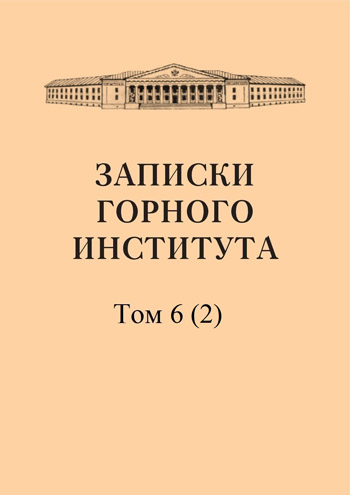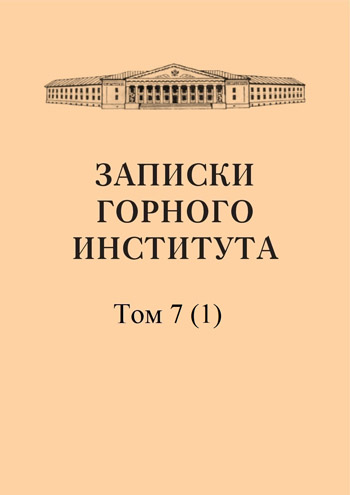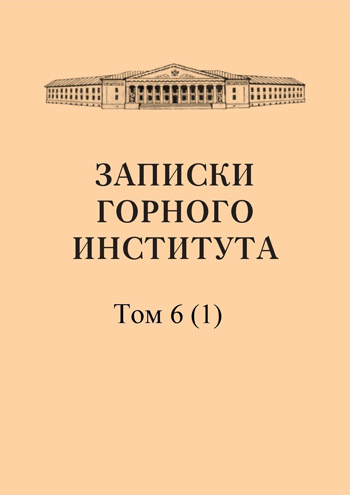-
Date submitted1917-06-20
-
Date accepted1917-08-21
-
Date published1917-12-01
A. Ya. Pehrna (Obituary)
- Authors:
- V. N. Yakovlev
Alexander Yakovlevich Pehrna (1878 - 1916) was born into a family of Estonian intellectuals. A. Ya. Pehrna received his secondary education at the 7th Petrograd Gymnasium. After graduating from high school, he entered Petrograd University in the natural department of the Faculty of Physics and Mathematics, from which he graduated in 1902 with a 1st degree diploma. Then he entered the Mining Institute, which he graduated first in 1910. While still a student, he took part in detailed geological research on the eastern slope of the southern Urals. These works provided him with material for several geological and paleontological articles on the Upper Devonian and Lower Carboniferous deposits of the Urals (see list of works in the article).
-
Date submitted1917-06-16
-
Date accepted1917-08-13
-
Date published1917-12-01
On the question of the microstructure of oolitic limestones
- Authors:
- E. E. Mitkevich-Volchasskii
While examining the petrographic material that I collected in 1914 during geological research in the Middle Vitim mountainous country, I came across specimens among limestone samples in which well-preserved oolitic deposits could be observed under a microscope, only partly masked by subsequent recrystallization. The significant interest represented by the discovery of oolitic formations among the metamorphic rocks of the Vitim Plateau prompted me to familiarize myself in more detail with the oolitic structure on material where the primary structure would not be obscured by secondary changes.
-
Date submitted1917-06-13
-
Date accepted1917-08-30
-
Date published1917-12-01
Correct triple periodicity of volumes of parallelohedrons
- Authors:
- E. S. Fedorov
If we divide a cube into eight cubes by three mutually perpendicular central planes, we get a periodic operation that we can continue endlessly in both directions. In this case, the volume of the cube decreases (or increases) eight times, that is, two in the cube. But this period is very simply divided into three smaller periods with a decrease (or increase) in volume by half. In this periodicity, a special role is played by A) the centers of the faces of the original cube and B) the centers of the cubes of the lower period.
-
Date submitted1917-06-14
-
Date accepted1917-08-13
-
Date published1917-12-01
A. Ya. Pehrna (Memoirs of a friend)
- Authors:
- Al. Borgman
Alexander (Elmar) Yakovlevich Perna was born on December 6, 1878 in the family of a people's teacher in the Estonian province. He studied at the Petrograd 7th gymnasium and already from his gymnasium years showed a special interest in natural science. After graduating from the gymnasium in 1898, Alexander Yakovlevich entered the Department of Natural Sciences of the Faculty of Physics and Mathematics of Petrograd University and was initially particularly interested in organic chemistry.After graduating from the University in 1902, he entered the Mining Institute. On December 3, 1916, he died of heart disease in one of the Finnish boarding houses. In the person of Alexander Yakovlevich, our homeland has lost not only a talented young scientist who undoubtedly showed great promise, but also a person exceptional in his high moral merits and a kind of deep thinker-philosopher.
-
Date submitted1917-06-11
-
Date accepted1917-08-15
-
Date published1917-12-01
Basic and fundamental parallelohedra of crystalline substances
- Authors:
- E. S. Fedorov
In the article “Results of the first stage of the experimental study of the structure of crystals,” the main parallelohedron denotes the smallest parallelohedron with the arrangements of atoms marked in it, from which the entire system of atoms is derived through the elements of bond symmetry. In the system of atoms there are therefore several different orientations of the main parallelohedrons with their atoms, and precisely by the magnitude of the bond symmetry (see article).
-
Date submitted1917-06-11
-
Date accepted1917-08-29
-
Date published1917-12-01
A. Ya. Pehrna. Funeral word by a representative of the Geological Circle of Mining Institute students
- Authors:
- B. Terletskii
Throughout the last year, A. Ya. Pehrna was the chairman of the Geological Circle. This Self-Education Circle arose in 1910 and once worked actively, but when in 1914 many of the participants joined the active army, the life of the Circle, which had been established over the years, was interrupted for almost a year and a half. Only A. Ya.’s exceptional energy and his exceptional personal charm were able to revive the Circle and bring it back to life in January of this year.
-
Date submitted1917-06-16
-
Date accepted1917-08-12
-
Date published1917-12-01
Providing for crystallization according to the arrangement of atoms
- Authors:
- Unknown
Direct experience shows that the phenomenon of crystallization is a very complex phenomenon in which various factors play a decisive role. Although, according to Steno's law, the angles between the corresponding faces in crystals of the same substance are constant, the appearance of forms that determine crystallization is far from being completely constant. At first glance, even the opposite appears to be true. From the same substance you can have crystals with a very limited number of pairs of faces, in exceptional cases not even reaching three, but you can also have crystals with a very rich combination. The forms that make up the combination are also very diverse in their development, and the very forms that in one case are predominant in size, in other cases fade into the background or are even completely suppressed by other forms.
-
Date submitted1917-06-11
-
Date accepted1917-08-18
-
Date published1917-12-01
Tikhon Semenovich Osennikov (In memory of the fighter who died for the freedom of Russia)
- Authors:
- V. K. Odrov
Tikhon Semenovich Osennikov graduated from a secondary educational institution - the Penza Real School - and was the only one in the family to enter a higher educational institution - the Mining Institute in 1911. Before completing the course at the Institute, he only had to complete his graduation projects when his young life was so suddenly interrupted. He died at the age of 23.
-
Date submitted1917-06-18
-
Date accepted1917-08-15
-
Date published1917-12-01
New concept of crystal structure and crystal chemical analysis
- Authors:
- E. S. Fedorov
To establish the structure, we were previously guided not by the full sum of combinations that a given crystal exhibits, but only by a small number of the most important pairs of faces. In this regard, as we see, no change has occurred. Even now we must first of all note these most important forms, but earlier we calculated the density of these forms, since, after all, the basis was the sequence of faces in order of importance. Now this calculation disappears and is even significantly simplified, because it only remains to determine from these forms which of the three zones these forms fall into.
-
Date submitted1917-06-22
-
Date accepted1917-08-02
-
Date published1917-12-01
Some data on the Lower Jurassic deposits of the Crimea
- Authors:
- M. V. Mukhin
A. A. Borisyak invited me to process the Liassic fauna collected by him and his colleagues from the outskirts of the city of Yalta and the village of Bodrak in the Crimea. In the vicinity of the city of Yalta, this fauna was noticed in the fence of one of the estates. A thorough search eventually led to a small abandoned quarry, where a block of limestone containing the named fauna was found among the shale.It was not possible to establish the mutual relationship of limestone and shale on the spot. Studies have provided undoubted paleontological evidence that part of the Crimean shale strata belongs to the Liassic, and the most abundant Liassic fauna was provided by the village of Bodrak and the environs of the city of Yalta.
-
Date submitted1917-06-13
-
Date accepted1917-08-10
-
Date published1917-12-01
Naphthalene from the Kukker shale of the Finnish coast
- Authors:
- E. S. Fedorov
The initial material was oil shale collected during exploration work by N.F. Pogrebov. After distillation of the illuminating gas, tar remains, which served as the material for this study. When this material is distilled in a water bath, crystalline, very thin plates of distilled organic matter with inclusions of another substance with much greater refraction and apparently capable of very good crystallization settle in the tube. This distillation was carried out by Mr. Valchis.
-
Date submitted1917-06-15
-
Date accepted1917-08-30
-
Date published1917-12-01
Funnels and caves of the Aleksandrovskaya Dacha in the Urals and phenomena associated with them
- Authors:
- V. N. Nekhoroshev
In the summer of 1914, in the area of the Aleksandrovskaya dacha (Perm province), a geological research led by the professor of the Mining Institute N.N. Yakovlev was carried out. I had to work in the eastern part of the dacha, and there I was able to observe those interesting geological phenomena that provided material for this note. The funnels are most remarkable of all these phenomena in this area (see article). Caves are among the other interesting phenomena. Of these, two are the most interesting in size, shape and nature of origin. The first, Vsevolodovskaya, is located at the very end of the limestone cliffs, going under them on the bank of the Chanva River. At first it looks like a large niche, in the side of which there is a gap that goes deep and stretches (together with the first niche) for 20 fathoms. Inside this cave there is a lake that gradually gets deeper towards the end of the cave. In the depths of the cave, approximately halfway, the walls of the cave are covered with stalactite deposits. The floor of the cave is littered with irregular blocks and fragments of limestone, which are also found under the water at the beginning of the lake.
-
Date submitted1917-06-08
-
Date accepted1917-08-04
-
Date published1917-12-01
More theorems on the relationships between linear and stereographic projections
- Authors:
- E. S. Fedorov
One theorem is that the distance of a gnomostereographic from a linear projection in a certain plane is equal to the distance from the last point of convergence of the rays. The proof boils down to the fact that the vanishing point of the rays Z, the gnomostereographic projection P and the midpoint of the linear projection of the plane O constitute the vertices of an isosceles triangle having the first points at the base, and this, in turn, comes down to proving the equality of the angles at the base.
-
Date submitted1917-06-24
-
Date accepted1917-08-19
-
Date published1917-12-01
Crystallization of some organic compounds and complex salts
- Authors:
- V. N. Orelkin
This work, which is my first work in the field of crystallography - the work of a student, covers substances of a random nature, delivered to me from various laboratories. The peculiarity of this work is that it is the first to use computational crystallography methods outlined in the articles of Prof. E. S. Fedorov: “Basic formulas of spherical and plane tetragonometry” and “Calculation of the numbers of the symbol of a complex ” (vol. IV, pp. 373 and 391, “Notes of the Mining Institute”), and the designations of the faces which coordinates were taken as the basis for the calculation , as well as the main constants of the complex of faces, are the same as in the indicated articles.
-
Date submitted1917-06-17
-
Date accepted1917-08-06
-
Date published1917-12-01
Work and pressure during rolling
- Authors:
- S. N. Petrov
The issues of work and pressure during rolling, obviously related to one another, have long been the subject of research, both theoretical and experimental. The number of large experimental studies devoted to these issues is small. For my part, I will dwell only on those conclusions of other researchers that the course of my research leads me to consider (see article). Kodron's theoretical research was accompanied by laboratory experiments on rolling lead bars between rollers of small diameter. I will dwell somewhat on these experiments in the future, since it was these experiments that first of all gave me the opportunity to verify the correctness of the theoretical formulas I had derived.
-
Date submitted1917-06-01
-
Date accepted1917-08-20
-
Date published1917-12-01
Essay on the activities of the Institute in the first days of the great Russian revolution
- Authors:
- Volume 6(2)
On February 28, at the Mining Institute, at the initiative of a radical group, a gathering of students took place with the participation of professors and employees of the Institute; a resolution was passed with the following content: "In view of the agreement between the Provisional Government and the Council of Workers' and Soldiers' Deputies on all current issues, the students of the Mining Institute condemn all kinds of uncoordinated speeches of various kinds and call on the country to support the Provisional Government and offer all their forces at its disposal until convening of the Constituent Assembly, which the students consider to be the true exponent of the country's wishes.


